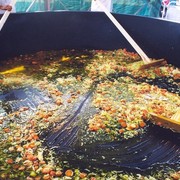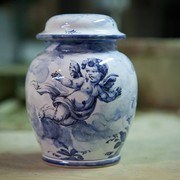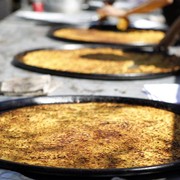The Eastern sacrifice of the lambs, in the Romanian pastoral folklore, is rich in traditions and rituals that reflect the lives of shepherds away from home for a very long period.
The way they spent their days and nights was a real school of information for them. There were told stories, were solved the problems, and all this took place around a "sacred" fire that should never been turned off until they were coming down from the mountains. Turn off the "sacred" fire was considered an unforgivable act of the shepherd in charge. There were also the men responsible of the lambs sacrifice and of the preparation of the Easter traditional products, all these accompanied by a ritualistic scenery.
It is said Easter dinner has to be "light" and it is usually made up of: maţe fripte or drob, which were initially prepared from the lamb’s intestines replaced in time by the animal’s organs. Considered in the past a poor people dish, it is nowadays a very beloved dish; zeamă de maţe, which is a soup of lamb intestine; the classic lamb soup, made from pieces of meat and vegetables, without forgetting to add in the end the lovage leaves, absolutely necessary for the authentic taste of the soup; roast lamb, according to the traditional recipe of Banat.
Besides the traditional recipes of the great religious celebrations, there are variations of other recipes, which are not necessarily related to one of the major feasts. Among these, in Banat we can eat "păturata pă crumpei" which is a vegetarian dish made of a kind of cheese stuffed strudel cooked on a potato bed, the "borândău dă crumpi" could also be found which is a sausage made from blood cooked on a potato bed, " maţă dă hoară fripce " which is a dish made of chicken with a white sauce.
As dessert, in Banat we can eat a variant of the strudel called "plaşintă-ncinsă" stuffed with seasonal fruit or cheese, the famous "clătite bănăţene" that are crêpes covered by egg foam and cooked in the oven, "crofne bănăţene " which is a sweet similar to donuts, and" haioş "which is a sweet made whit lard.
Among all these Banat traditional recipes, there are few local restaurants that still prepare them, on the one hand because the meats are prepared at home, according to the secular recipes, and on the other hand, consumption of foreign tourists of the traditional products is so low as not to be taken into account.
For those who are interested in traditional local products, lately there are developing local farms that promote the local gastronomic traditions and more other specialties.
Bibliografia:
1. Gheorghe Secheşan, Tradiţii şi obiceiuri culinare bănăţene, Ed. Eurostampa, Timişoara, 2012,
2. Ion Ghinoiu, Vârstele timpului, Ed.Meridiane, Bucureşti, 1998.

















